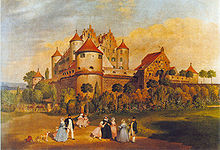Ulm (noble family)
The Imperial Knights and Barons of Ulm were a Swabian noble family that branched out into several lines. Until the middle of the 12th century, the Erbishofen family named themselves after the place of the same name in the municipality of Pfaffenhofen an der Roth in the Neu-Ulm district .
A genealogical connection with the people who appeared in north-eastern Switzerland in the 13th and 14th centuries and called themselves Ulm cannot be proven.
Origin of the family
Heinrich von Erbishofen was from Emperor Konrad III. in the shortly before by Emperor Lothar III. destroyed city of Ulm used as Vogt . Otto von Ulm, called Erbishofen, was imperial bailiff of Augsburg and received the knighthood from Emperor Rudolph I in 1273 . With his great-grandson, knight Heinrich von Ulm (1348), the family's uninterrupted genealogy begins. Heinrich's son Johann was enfeoffed with Litzelstetten near Constance by the St. Gallen Abbey in 1363 . From Litzelstetten, the family branches out into several branches.
Constance line

From Konstanz originating patricians were partly in the 16th century Zurich verbürgert. The progenitor of the Konstanz line, Heinrich († around 1430), mayor of Konstanz at the time of the council , who was knighted by Emperor Sigismund , is considered certain . One branch each of Ulm came from the brothers Hans Jakob, Heinrich and Gregor.
Hans Jakob († 1539 at the latest) received the jurisdiction of Teufen through his marriage to Barbara Zum Thor in 1519 . His son had no male descendants and so the rule of law went to his son-in-law Hans von Meiss in 1571 .
Heinrich († 1581) acquired the castle and lordship of Griesenberg in 1529 . His son Heinrich (1537–1601) obtained Zurich citizenship in 1576, which his son Marx lost after converting to the Catholic faith. In 1612 Marx was given Lucerne citizenship. In 1704 the Lucerne branch line went out.
Gregor acquired the dominions of Wellenberg and Hüttlingen , which remained in the family's possession until 1669 and 1674 respectively. From 1674 the members of this line were citizens of Zurich. The court lords only had Zurich citizenship sporadically and were therefore little involved in Zurich politics. Friedrich Ludwig (1668–1729) was a member of the Grand Council as an eighteenth (representative of the Constaffel ) and Obervogt von Wellenberg and Hüttlingen in 1716 . With his son of the same name, the Swiss branch of Ulm died out in 1674.
Ulm to Marbach and to Wangen
Heinrich von Ulm was enfeoffed by Emperor Sigmund with the imperial tax of the city of Wangen . Hans Conrad von Ulm zu Marbach and Caspar von Ulm zu Wangen received a confirmation of the nobility and an improvement in the coat of arms in 1551 .
Ulm to Langenrain
The rule of Langenrain came in 1655 through an inheritance from the Lords of Bodman to the Barons of Ulm zu Griesenberg. From 1684 to 1686, Marx Anton von Ulm had Langenrain Castle built there. Heinrich von Ulm-Langenrain was Prince Abbot of Kempten from 1606 to 1617 as Heinrich VIII . With the extinction of the Langenrain branch, their rule fell back to the von Bodman-Möggingen family in 1814.
Ulm to Erbach
Hans Ludwig (1567–1627) was the brother of Prince Abbot Henry VIII of Ulm-Langenrain and from 1613 Vice Chancellor of the Holy Roman Empire . He received the coats of arms of the extinct families Marbach and Ellerbach and carried the title Freiherr auf Erbach , Marbach, Wangen and Mittelbiberach . His marriage to Euphrosyne Schad von Mittelbiberach brought him the manors of Mittelbiberach and Sulmentingen.
Adam Joseph Ignaz, imperial bailiff of Burgau and the princely Augsburg high steward , was raised to the rank of imperial count in 1726 . Carl von Ulm zu Erbach was k. k. Chamberlain and privy councilor and in 1769 became the district president of Upper Austria . Maximilian Marquard von Ulm-Erbach-Mittelbiberach was a member of the Second Chamber of the Württemberg Landtag from 1841 to 1843 .
Members of the Ulm-Erbach family now live at Erbach Castle and Warthausen Castle in the Biberach district.
Web links
Individual evidence
-
↑ a b c d e f Constantin von Wurzbach : Ulm von Erbach, the barons, genealogy . In: Biographisches Lexikon des Kaiserthums Oesterreich . 49th part. Imperial-Royal Court and State Printing Office, Vienna 1884, p. 6 ( digital copy ).
These sections are largely based on the public domain entry in the Biographical Lexicon of the Kaiserthums Oesterreich. whose author died more than 100 years ago. -
↑ a b c d e Katja Hürlimann: from Ulm. In: Historical Lexicon of Switzerland .
These sections are largely based on the entry in the Historical Lexicon of Switzerland (HLS), which, in accordance with the HLS's usage information, is licensed under the Creative Commons - Attribution - Share Alike 4.0 International (CC BY-SA 4.0) license . - ↑ a b Langenrain. On the website of the municipality of Allensbach, accessed on February 29, 2020
- ↑ George Dehio, Dagmar Zimdars (Ed.): Handbook of German art monuments. Baden-Württemberg II . Deutscher Kunstverlag, Berlin and Munich 1997, ISBN 3-422-03030-1 , p. 408.
- ^ Henning Petershagen accolade for Heinrich von Ulm. In: Südwest Presse (online), June 13, 2014



